8 Things to Know about Electric School Bus Repowers
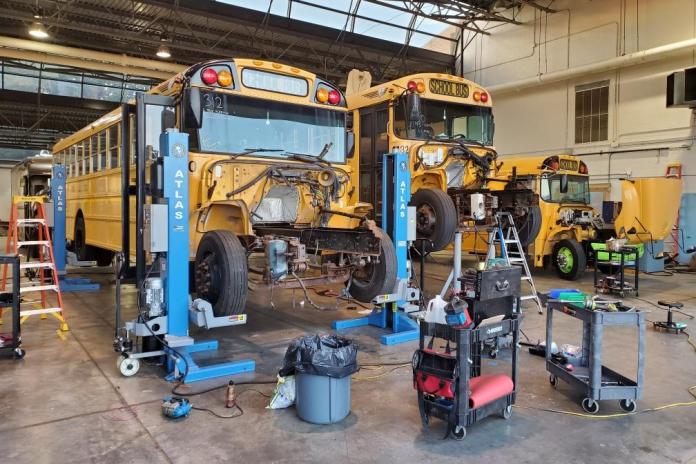
Photo credit: Unique Electric Solutions
Repowering existing school buses with a new electric drivetrain shows promise to provide school bus operators with a lower cost and more sustainable vehicle compared to buying a brand-new electric school bus. An electric repower — sometimes referred to as an electric conversion or retrofit — involves the removal of a vehicle’s internal combustion engine that runs on a fossil fuel like diesel, gasoline, propane or natural gas and replacing it with an electric drive system, transforming the vehicle to one that is fully battery-electric with no tailpipe emissions. Repowers present a unique approach to fleet electrification and have prompted questions and interest from many involved in advancing school transportation.
Today, electric conversions are performed on several vehicle types. In the United States, this includes heavy-duty transit buses and motorcoaches. Now, the yellow school bus is taking center-stage as the next opportunity to deploy this technology. The first school bus repowers were performed in 2014, but more recently, the availability of this technology has grown substantially with repowered school bus models currently available from several electric vehicle conversion companies.

In recent months, interest in this technology continues to build momentum, bolstered by public repower announcements. This includes a partnership between SEA Electric and the bus dealer, Midwest Transit to repower 10,000 school buses over the next five years; Blue Bird Corporation’s factory certified repower program with Lightning eMotors to convert Type C gas- and propane-powered school buses; and additional deployments from Unique Electric Solutions, who has seven repowered electric school buses in operation today.
As experience with repowers grows, we will continue to learn about the benefits and challenges of this approach. Here are eight things school bus operators should evaluate when considering repowered buses to meet their electrification goals.
1) Repowered School Buses Cost Less than New Electric School Buses
Repowered buses have lower upfront purchase prices than new electric school buses. While brand new buses typically cost over $300,000, repowered school buses can cost substantially less — usually between $110,000 to $180,000 (excluding a used bus purchase). The bus to be repowered can be sourced from within a fleet, or a used bus can be purchased. Depending on the approach, this can impact the upfront price of repowering.
Like all electric vehicles, repowered buses can be expected to have lower maintenance costs than those with internal combustion engines. Similarly, the costs of charging infrastructure are equivalent to what is needed for new electric school buses. Repowers may also qualify for certain state government incentive programs, and for school districts with limited or no grant funding, repowers can offer a lower price solution than the purchase of a new electric school bus.
2) Incentive Programs Can Help Fund Repowers
Several state programs support repowered electric school buses by including them as eligible vehicle types in policies or incentives. The lower upfront price of repowers can increase the impact of incentive dollars, further lowering the purchase price for school districts.
Voucher programs in California and New York allow up to $43,500 and $120,000, respectively, for eligible repowered school buses. In Colorado, recent legislation created a new $65 million grant program that explicitly includes electric repowers. Similarly, in New Jersey, a $45 million pilot program allows for the inclusion of repowered school buses.
Repowers can help states meet fleet electrification goals, since they can help increase the available production capacity of electric school buses, which remains limited in scale compared to conventional school bus manufacturing.
For federal funds, the EPA Clean School Bus Program, clarified that under certain conditions, electric conversions may be an eligible bus type for its first round of rebates, but has not yet awarded any. Similarly, repowers could qualify under the Diesel Reduction Act (DERA) program, but this approach has not been used. Going forward, there are opportunities for both programs to consider how to more fully support repowers for electric school buses.
Some existing funding programs designated for electric school buses, such as state-administered Volkswagen Settlement Funding, requires scrapping the old fossil-fuel bus when replacing it with a new bus. This involves drilling a 3-inch hole in the engine block and/or cutting the vehicle frame rails. Where bus replacement programs consider scrapping of the engine block to be a sufficient demonstration of scrappage, the chassis and bus body can be used for a repowered model.
3) Repowered School Buses Offer Environmental, Health and Social Benefits
Like new electric school buses, repowering offers several health benefits for children and their communities by reducing exposure to diesel exhaust — which has known links to physical health effects, including cancer and asthma, as well as cognitive impacts. If a diesel school bus is repowered rather than sold, it can prevent that internal combustion engine from continuing to pollute in another state or country, assuming the engine is scrapped.
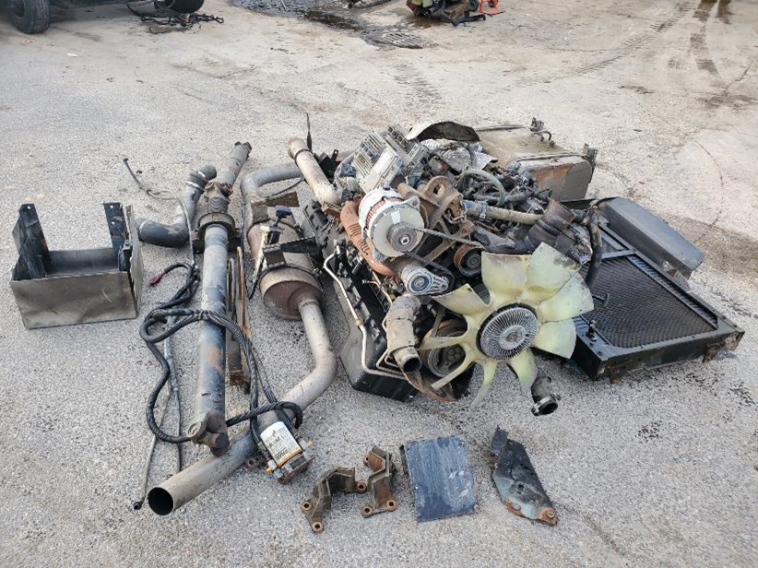
The emissions benefits of repowers also go beyond vehicle operation. When repowers result in an extended life of a bus’s chassis and bus body, they may be responsible for even lower manufacturing-related carbon dioxide emissions than newly-manufactured electric school buses. This includes avoided manufacturing emissions associated with building a new bus and reduced demand for emissions-intensive materials like steel, promoting a more circular economy.
Finally, repowers have the potential to incorporate more local labor involvement. With proper training and facilities, authorized dealers and school bus operators can potentially perform a repower locally with a repower system (or kit) shipped to them.
4) The Repower Process and Supply Chain Mimic that of Brand-New Electric School Buses
Brand new electric school buses are typically built by integrating an electric vehicle drive system with batteries and other high-voltage components into a chassis and then attaching the bus body. Some manufacturers use a more vertically integrated model where they may produce much of the powertrain, battery packs, bus body, chassis and other parts in-house while others use a diversified supply chain relying on several suppliers for these components.
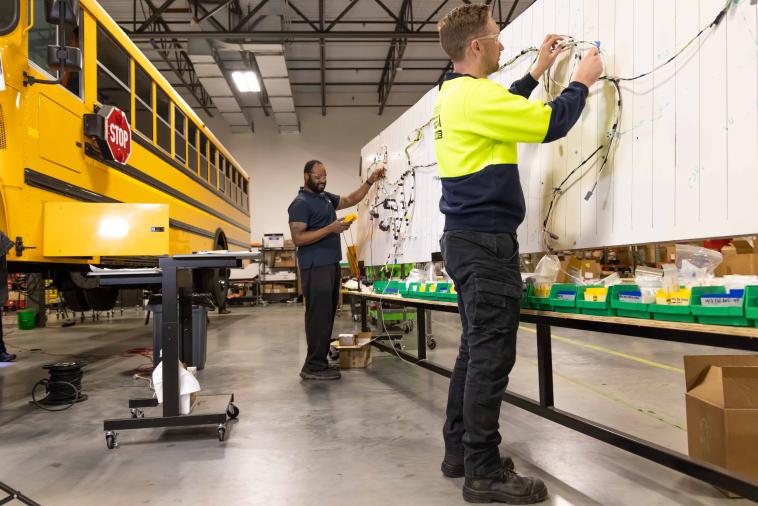
Repowered school buses are typically built with a similar electric drive system to new electric school buses and often use the same suppliers for battery packs and other components. The key difference is repowers do not use a brand-new chassis and body and instead take advantage of an existing bus from a fleet or dealer. The most complex part of school bus repowering is ensuring the new electric powertrain system seamlessly integrates with existing systems in the bus chassis and body (steering, brakes, lights, instrument cluster, etc.). Depending on the bus, repowering may also involve refurbishing the interior or exterior of the bus, such as adding new seats or a fresh coat of paint.
In addition, the repower process is more prevalent in electric school bus manufacturing than meets the eye. In the 2010s, before medium- and heavy-duty electric vehicles were widely available for purchase, many start-ups and demonstration projects purchased a new or used diesel vehicle and converted it with an electric drive system. This manufacturing model persists in some new electric school buses produced today, especially for Type A school buses (small buses that typically carry 10 to 16 passengers). As of 2023, more than half of electric Type A school bus models available are new-vehicle repowers. These buses are constructed using a new internal combustion engine cutaway from Ford or General Motors, the engine is removed, and an electric drive system is installed — all of which occurs before the bus goes into service.
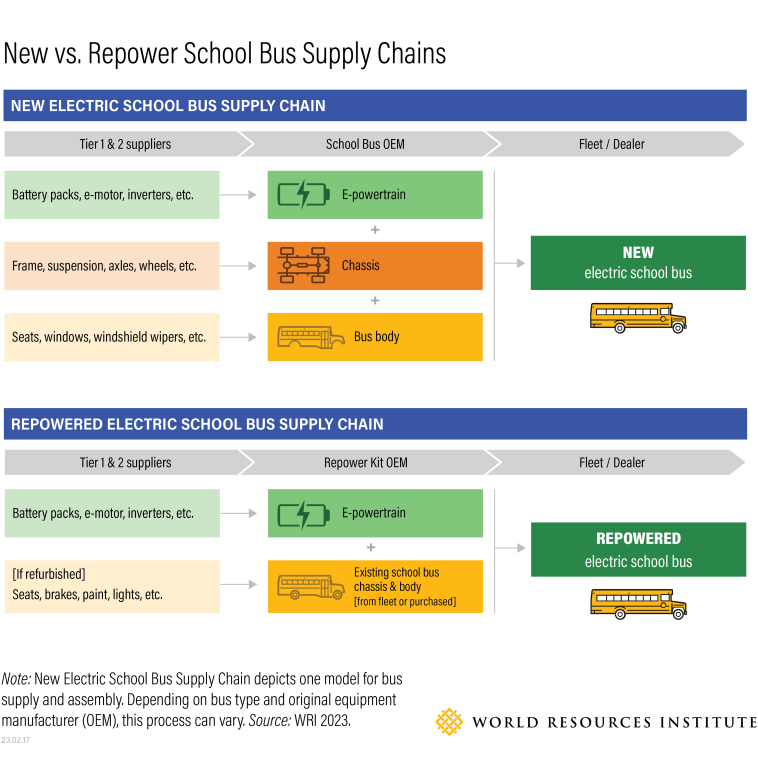
5) Repowers Can Avoid Some Supply Chain Hurdles
Due to current supply chain challenges, repowers also have the potential to meet the growing demand for electric school buses because they require fewer parts from global suppliers than new buses. This supply advantage is most relevant for any delays that may arise on school bus chassis and body components. Because new and repowered buses use a comparable electric powertrain, both would face supply challenges for batteries, inverters, or electric motors. With this benefit, repowers can further increase the available annual production capacity for electric school buses.
6) More Companies are Offering Commercial Electric School Bus Repowering
The electric school bus sector has both established repower companies and new, emerging businesses. Unique Electric Solutions (UES) and SEA Electric have public orders or deliveries of repowered electric school buses in the U.S., and Blue Bird Corporation, a nearly century-old school bus manufacturer, recently announced repowers would be available for select internal combustion engine buses in partnership with Lightning eMotors beginning 2023. Several emerging repower companies have also announced their intention to expand into the school bus repower market.
| Company | ESB repower locations | Bus types repowered | ESB repower cost (excluding a used bus purchase) | Has the company delivered repowers? | Does the company repower other vehicle types? | Available battery and electric drivetrain warranty? |
Robbinsville, NC | A, C, D | $120,000-$180,000 | No | Vans & tactical vehicles | Yes | |
Authorized Blue Bird conversion centers in the U.S. and Canada | C | Repower pricing lower than initial purchase cost of equivalent EV | No | No | Yes | |
Tempe, AZ | A, C, D | Parts starting at ~$120k Labor ~$20k - $80k | No | Vans, trucks, street sweepers, boats, utility vehicles, and more. All delivered. | Yes | |
Authorized Fontaine Modification locations | A | NA | No | Vehicles built on Ford E-450 platform | Yes | |
Anaheim, CA | A | NA | No | Any body or application build on Ford E-450 platform | Yes | |
Des Moines, IA | A, C | <$150,000 | Yes | Yes | Yes | |
Holbrook, NY Costa Mesa, CA | A, B, C, D | $110,000-$175,000 | Yes | Shuttle bus, motorcoach, class 3-8 trucks | Yes |
Source: Electric School Bus U.S. Buyer's Guide 2023, company websites, ESB Initiative correspondence with companies. Note: Inclusion in this list does not constitute endorsement and the World Resources Institute and the Electric School Bus Initiative do not recommend any firm over another.
7) Age of a Repowered School Bus Matters
The age of the internal combustion school bus that will be repowered can affect performance, cost, environmental benefits and usability of the bus. For example, repowering a 10-year-old school bus will mean having an electric bus with older brakes, seats, paint and accessories while repowering a 3-year-old bus will mean starting with newer parts. The cutoff for a “new” versus “old” school bus is subjective and depends on the mileage, wear-and-tear, weathering, and other conditions of the base bus. Some repower add-ons can include refurbishing the bus by adding newer bus seats or coat of yellow paint.
When repowering younger buses this may mean that, like a new electric bus, the repower’s high-voltage battery could reach its end-of-life and require replacement before the rest of the vehicle reaches its own end-of-life. Based on a review of warranties, electric school bus battery lifespan is estimated to be about 8 years, but because electric school buses are a relatively newer technology, it is too early to assign exact figures. For new or repowered buses, battery replacement should be factored into total cost of ownership estimates.
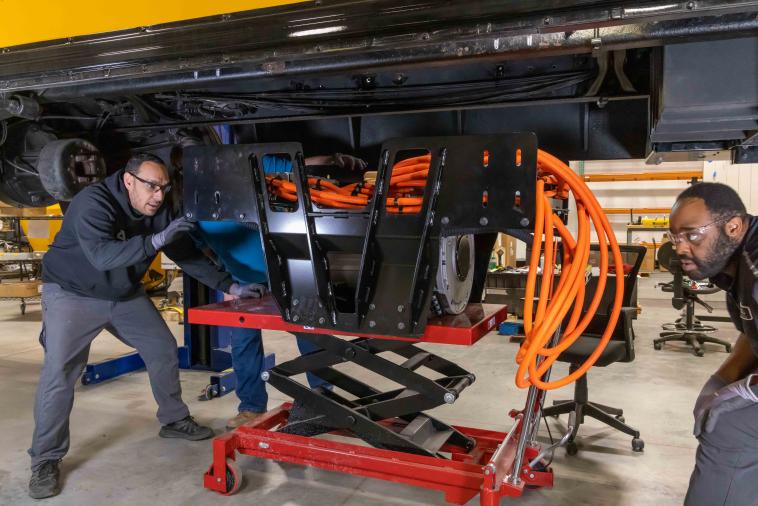
In addition to bus wear-and-tear, it also may be necessary to factor in regulations on bus age. States and school districts may limit the age of school buses used for student transportation. In New Jersey, for instance, some school buses can only be used for student transportation for 12 years from the date of manufacture, which significantly limits the useful life of a repowered school bus and may mean repowering makes less sense for older buses. To open the door for repowers, these regulations, created in part to limit emissions, may need to be revised.
Repower companies often prefer to focus on buses from a specific original equipment manufacturer (OEM), produced within a limited range of model years to reliably repower buses with similar chassis specifications and documented wiring diagrams. The company conducting the conversion ideally has the wiring diagrams and electrical schematics of the base bus from the OEM to ensure existing electronic and mechanical systems properly integrate and function with the new electric drive system. Depending on the bus make and model year, it may or may not fit expectations of the repower company. This can increase the time and cost of repowering, especially if the make and model of that bus has not been repowered previously.
Tradeoffs of Repowering Internal Combustion Engine School Buses vs. New Electric School Buses:
| Older school bus repower (>7 years) |
| Pros (italicized items are unique to older repowers): |
|
| Cons (italicized items are unique to older repowers): |
|
| Newer school bus repower (<4 years) |
| Pros (italicized items are unique to newer repowers): |
|
| Cons (italicized items are unique to newer repowers): |
|
| Brand new ESB |
| Pros: |
|
| Cons: |
|
Notes: The listed pros and cons linked to bus age may vary by bus type, weathering, state regulations, and repower company. Source: WRI.
8) Safety Compliance and Regulations Vary
School buses fall into specific safety and compliance regulations at the federal, state and sometimes local levels. Whether a repowered bus meets those specifications will vary based on the bus and the existing regulatory approach. Fleets can request documentation on various safety and testing requirements to ensure that repowered school buses will meet or exceed safety regulations and are able to operate in their state or local area, especially if the bus will operate in a new locality.
At the federal level, the National Highway Traffic Safety Administration issues Federal Motor Vehicle Safety Standards which implements laws to maximize safety for all U.S. vehicles. Repower manufacturers may be considered vehicle alterers or modifiers, which can dictate the specific safety standards still in compliance from the original vehicle and special labeling.
In addition, there are 50 different state school bus compliance considerations. For example, in California, the California Highway Patrol must be involved in inspecting and approving a new school bus for use, and in New York, the New York State Department of Transportation inspects all school buses at least every six months. In Florida, the Department of Education recently approved updated school bus specifications that explicitly exclude buses converted to electric. There may also be local regulations and policies for school buses like width limitations in New York City or required third-party testing like the Altoona Bus Testing.
Looking Ahead
Repowered school buses use a comparable electric powertrain to a brand-new electric school bus, priced at around half the cost of a new electric school bus. This approach to school bus electrification can help mitigate current supply chain challenges, promote a more circular economy and may even reduce waste and manufacturing-related emissions. While there are limited numbers of repowers on the road today, there is an increasing number of state and local provisions for repowers in funding programs. For the ever-growing list of school districts and fleet operators looking to electrify and facing the high cost of new electric school buses, repowers present a promising option to complement new vehicle orders and accelerate the transition to zero-emission school bus fleets.